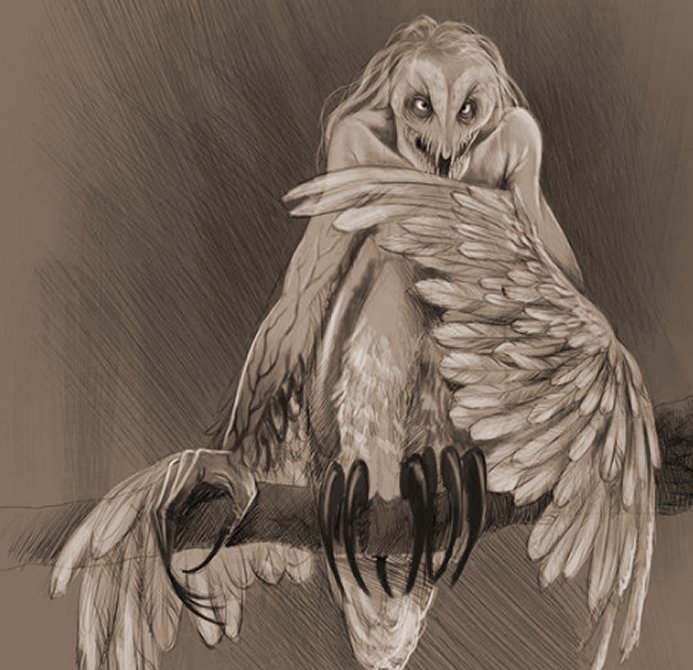Strzyga (Strix): Slavic Malevolent Winged Female Demon With Two Souls That Usually Haunts Churches, Towers, Barns
A. Sutherland - AncientPages.com - In Slavic mythology, this winged demon is called Strzyga (in Polish). In beliefs of other cultures is known as Strix (Strigoi). Rarely known in the male form, Strzyga is somewhat similar to vampire.
Strzyga, an artistic vision by Filip Gutowski. Excerpt from The Sarmatian Bestiarium by Janek Sielicki. Image credit: Filip Gutowski - Janek Sielicki - CC BY-SA 4.0
In the Greco-Roman beliefs, a witch was called a strix (Strigoi), who took the form of a bird under the cover of the night. In beliefs of classical antiquity, the strix, was a bird of bad omen.
According to some accounts, this ominous large-headed bird had a human face, human fingers that were curved like claws, greyish white bat wings, yellow transfixed eyes, four legs and a long, voracious beak, which was used to suck the blood of its victims or fed on their bodies. Her breath was believed to be poisoned and her victims were most often sleeping infants.
But among ancient Greeks and Romans, this malevolent creature fed more often, on ‘spiritus vitae’, the life force (literally ‘breath of life’) of the victim. A cemetery was believed to be the creature’s favorite place, where its crying was usually heard at night-time.
Where Did This Demon Come From?
The souls of people, who were born with two hearts, two souls, and a double row of teeth, are left to be stalked; they usually become the strixes. In the first life, they are mostly harmless and not much different from other people, because their second raw of teeth is almost invisible. Later, when their true destiny comes out, they suffer because of their otherness.
See also
Stikini ‘Man-Owl’ – Sinister Vampiric Monster That Works In Disguise
Dearg-Due Frightening Female Demon And Tyrannical Abhartach Of Irish Folklore
Camazotz: “Death Bat” Vampire God In Ancient Maya Beliefs
Empusa – Shape-Shifting Evil Female Demon In Greek Myth And Folklore
In Slavic beliefs, the Strzyga usually dies at a young age, but when one soul leaves, the other survives to begin hunt.
Many of them can turn into owls; they are lonely hunters, do not join others living in clusters and have no other desires than satisfy hunger.
Sometimes, they want revenge for the harm they suffered in their first life.
Is It Possible to Defend Against This Vampire?
It was possible to defend against the strix by hanging branches of hawthorn in the window, sprinkling the threshold with water, or giving it to drink the blood of a pig, a substitute for child's blood.
The creature could be recognized by the characteristic blue glow that surrounded its body at night. Their victims could be recognized by the fact that the left eye always remained open and immobile.
The ancient Romans believed that their goddess Carna, patron of the door, was also a divine babysitter and a protector, who, by means of magical spells, chased away the strix. When the strix occasionally appeared in the church tower at night, this ominous bird heralded an imminent death to all who were within her sight.
Strzyga And Witch Hunt
In later folklore dated the 16th century, these demonic creatures used to attend a witches' Sabbath, where they fought with each other. If an accidental mortal strayed in the area and witnessed such a fight, he ended up being beaten and with the arrival of dawn losing his memory of the whole event or speech.
Along with sunrise, or with the early morning ringing of church bells, they had to end their night activities and go back to abandoned houses to deal with weaving, spinning wool, and sewing linen shirts for themselves. If they had not left at the appointed time, they were supposed to crumble in half and lose their powers, similar to vampires when their powers are often limited during the day or in daylight.
Also Stikini (‘man-owl’), in ancient folklore of the Seminole Indians of Oklahoma had to return back before dawn because sunlight had disastrous consequences for the creature’s supernatural abilities to turn back into human shape. Likewise, the all-knowing dwarf Alvis in Norse mythology, who forgot that his kind could never face the light of day, and disappeared.
Written by – A. Sutherland - AncientPages.com Senior Staff Writer
Updated on Apr 11, 2024
Copyright © AncientPages.com All rights reserved. This material may not be published, broadcast, rewritten or redistributed in whole or part without the express written permission of AncientPages.com
Expand for referencesReferences:
Whitacre D. Neotropical Birds of Prey
Sherman, Storytelling. An Encyclopedia of Mythology and Folklore
More From Ancient Pages
-
 New Large Sphinx Still Embedded In Soil Discovered In Luxor, Egypt
Archaeology | Aug 10, 2018
New Large Sphinx Still Embedded In Soil Discovered In Luxor, Egypt
Archaeology | Aug 10, 2018 -
 Legend Of Marguerite de Bressieux: Brave Noblewoman Who Sought Revenge For Sexual Assault
Featured Stories | Mar 29, 2020
Legend Of Marguerite de Bressieux: Brave Noblewoman Who Sought Revenge For Sexual Assault
Featured Stories | Mar 29, 2020 -
 Capoeira: Ancient Martial Art Disguised As A Dance Became A Symbol Of Resistance To Oppression
Ancient History Facts | Jun 8, 2018
Capoeira: Ancient Martial Art Disguised As A Dance Became A Symbol Of Resistance To Oppression
Ancient History Facts | Jun 8, 2018 -
 Remains of Maurya-Era Wall Discovered In Tilaurakot, Kapilvastu, Nepal
Archaeology | Jun 16, 2022
Remains of Maurya-Era Wall Discovered In Tilaurakot, Kapilvastu, Nepal
Archaeology | Jun 16, 2022 -
 Rare 2,800-Year-Old Assyrian Scarab Amulet Found In Lower Galilee
Archaeology | Feb 24, 2024
Rare 2,800-Year-Old Assyrian Scarab Amulet Found In Lower Galilee
Archaeology | Feb 24, 2024 -
 Ancient Scandinavians Never Spoke Of Themselves As Vikings – Here Is Why
Ancient History Facts | Mar 15, 2021
Ancient Scandinavians Never Spoke Of Themselves As Vikings – Here Is Why
Ancient History Facts | Mar 15, 2021 -
 Enigma Of Lycurgus Of Sparta – Great Reformer And His Foundation Of A Warlike Superior State
Featured Stories | Jan 9, 2023
Enigma Of Lycurgus Of Sparta – Great Reformer And His Foundation Of A Warlike Superior State
Featured Stories | Jan 9, 2023 -
 Chain Mail Reveals Roman Soldiers Recycled And Repaired Their Own Armor
Archaeology | Dec 12, 2024
Chain Mail Reveals Roman Soldiers Recycled And Repaired Their Own Armor
Archaeology | Dec 12, 2024 -
 Evidence From Ancient Egypt Shows Smallpox Stretches Back At Least 3,000 Years
Archaeology | Jan 11, 2023
Evidence From Ancient Egypt Shows Smallpox Stretches Back At Least 3,000 Years
Archaeology | Jan 11, 2023 -
 New Discoveries In Excavated Ancient Temple Linked To Secret Mithras Religion
Archaeology | May 15, 2018
New Discoveries In Excavated Ancient Temple Linked To Secret Mithras Religion
Archaeology | May 15, 2018 -
 12 Ancient Myths, Legends And Biblical Stories Confirmed By Modern Science
Featured Stories | Apr 22, 2017
12 Ancient Myths, Legends And Biblical Stories Confirmed By Modern Science
Featured Stories | Apr 22, 2017 -
 Royal Tombs Of Alexander The Great’s Family At Vergina, Greece Finally Identified
Archaeology | Jan 31, 2024
Royal Tombs Of Alexander The Great’s Family At Vergina, Greece Finally Identified
Archaeology | Jan 31, 2024 -
 Lilith – Beautiful Demonic And Brave Symbol Of Equality And Adam’s First Wife Who Refused Subordination
Biblical Mysteries | May 24, 2020
Lilith – Beautiful Demonic And Brave Symbol Of Equality And Adam’s First Wife Who Refused Subordination
Biblical Mysteries | May 24, 2020 -
 500 Million Year-Old Fossils Solve A Centuries-Old Evolutionary Riddle
Archaeology | Nov 7, 2022
500 Million Year-Old Fossils Solve A Centuries-Old Evolutionary Riddle
Archaeology | Nov 7, 2022 -
 Collection Of 59 Well-Preserved 26th Dynasty Coffins Unearthed In Saqqara Necropolis, Egypt
Archaeology | Oct 4, 2020
Collection Of 59 Well-Preserved 26th Dynasty Coffins Unearthed In Saqqara Necropolis, Egypt
Archaeology | Oct 4, 2020 -
 Mystery Of Moses’ Double Mask, Dramatic Personality Change And The Hidden Prophet – What Did Really Happen On Mount Sinai?
Ancient Mysteries | Jun 25, 2018
Mystery Of Moses’ Double Mask, Dramatic Personality Change And The Hidden Prophet – What Did Really Happen On Mount Sinai?
Ancient Mysteries | Jun 25, 2018 -
 How Did Ancient People Wake Up On Time Before The Alarm Clock Was Invented?
Ancient History Facts | Mar 29, 2025
How Did Ancient People Wake Up On Time Before The Alarm Clock Was Invented?
Ancient History Facts | Mar 29, 2025 -
 900-Year-Old Crypt At Old Dongola: Magical Inscriptions And Mysterious Signs Found
Archaeology | Sep 12, 2015
900-Year-Old Crypt At Old Dongola: Magical Inscriptions And Mysterious Signs Found
Archaeology | Sep 12, 2015 -
 Number Nine: Sacred Symbol In Ancient Cultures
Ancient Symbols | Feb 14, 2017
Number Nine: Sacred Symbol In Ancient Cultures
Ancient Symbols | Feb 14, 2017 -
 Satellite Images Reveal Ancient Mesopotamian City Pre-Dating The Egyptian Pyramids
Archaeology | Mar 10, 2022
Satellite Images Reveal Ancient Mesopotamian City Pre-Dating The Egyptian Pyramids
Archaeology | Mar 10, 2022


